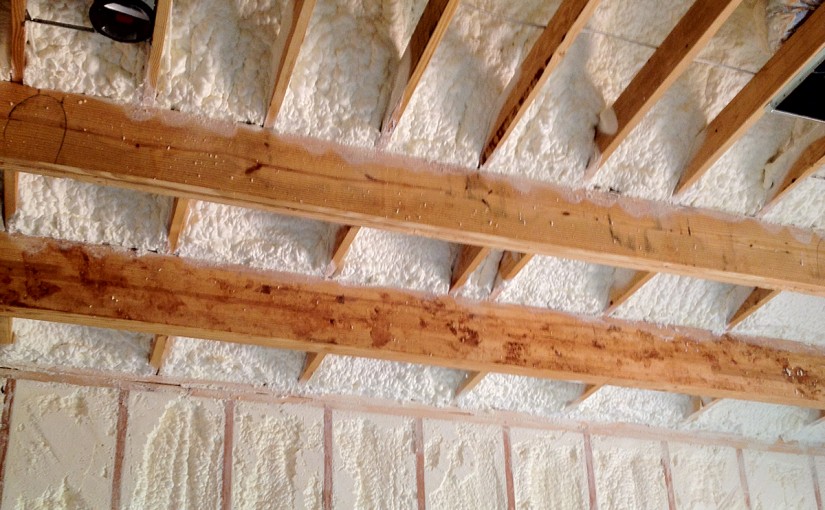
The point of home insulation is to prevent sound or heat from moving from one space to another. Typically it is used in walls, attics, and floors to prevent heat or cold from moving into your living space. It can also be used to keep sound out of, or in your home. There are different types of raw materials that make up insulation, but the approach is usually the same. Materials are fabricated to create millions of tiny air pockets. The material along with the air pockets resists thermal transmission.
Insulation To Control Thermal Transfer
When the majority of people think of insulation it is heat control insulation they are thinking about. Thermal insulation is found in commercial and residential buildings in the attic, walls, ceilings, and even some floors. The outside walls and attic are the two areas that are usually most critical in keeping our homes comfortable.
The goal of thermal insulation is a very simple one, to keep either the heat or cold out of our homes. Depending on the region of the world you live in your insulation will be designed with a passive element to help accommodate the temperature swing from winter to summer. If it is always cold or hot where you live the insulation approach will be dedicated to prevent heat from entering or escaping.
R value is the term used to describe how much heat is controlled by any given insulation. The higher the number, the more effective the insulation is in preventing heat transfer. There are two ways R value is expressed in modern construction. The first is the overall R value of a structure including all building materials and the insulation, also known as RT. The second is the R value of each insulation type, also known as Rm. R values help make apple to apple decisions between various types of insulation.
Insulation To Control Sound Transfer
The word insulation also applies to the prevention of sound transfer. This can mean the sounds coming from outside your home which can disturb sleep, or it can mean sounds from your home. While all insulation also helps with refusing sounds there are dedicated acoustic insulation types. Acoustic insulation is typically only found in specialized rooms, like theater rooms in homes. It is installed in the floor, walls, and ceiling to keep the sound from disturbing others in the home, or neighbors.
If you live near a hospital, airport, or busy road you will also enjoy better sleep with insulation keeping the sound outside. There are specifically engineered products that will help keep those sounds out of your home and help you get more restful sleep.
Can’t Insulation Do Both Jobs?
Thermal insulation does reduce noise from outside and acoustic insulation does help with some heat transfer. However both are specialized for their specific purpose and lean towards their goals. For most quiet neighborhoods having thermal insulation is enough to keep the home quiet enough. However acoustic insulation can still be a good idea if there are bedrooms near other living spaces. It keeps the house sectioned off and helps people enjoy both spaces more.
What Types Of Insulation Are Available?
There are a few different types of insulation, all with their own particular benefits. Some are less expensive, and others have unmatched R values. Speak with your insulation professional about which will work best with your home.
Batt Insulation
Batt insulation is probably the most common type people think of when asked about insulation. Batts are generally made from rockwool or fiberglass. They are light panels with paper backing that are installed in between the studs in the walls and the rafters in attic spaces. Batts trap millions of tiny pockets of air between their fibrous materials.
Blown In Insulation
Another very common type of insulation is blown in insulation. Generally speaking the material is made up of cellulose or even recycled newspaper or denim. The material is blown by a machine into the attic and lays on the floor. Insulation techs make a nice even layer of the insulation that lays on the floor of the attic.
Spray In Insulation
One of the newer and best insulation types available is spray in insulation. It comes in two variants, closed and open cell insulation. Open cell spray foam is water permeable and creates millions of tiny open pockets of air. Closed cell has one of the best R values available because it also creates millions of tiny air pockets. However it is more effective because the pockets are closed and trap pockets of specialized gas. Each type helps to seal up gaps in the attic and the walls it is installed in.
Acoustic Insulation
Insulation that is designed to give the maximum sound resistance generally consists of much higher density material. It is often made with polymer based materials like glue or rubber. While it will help with some heat transfer the tight nature of the material is not as good as thermal insulation. It is a good product to use in conjunction with thermal insulation to get the perfect combination of comfortable temperatures in the home, and the quiet sanctuary all of us desire.
Phoenix Valley Insulation Installation
If you have a drafty home that isn’t staying warm in winter or cool in summer you probably either don’t have insulation, or have worn out insulation. The experts at Barrier Insulation will happily do an insulation inspection and help you find the weak points in your home’s thermal barrier. This will do more than keep you comfortable, but help dramatically reduce your energy bills. To get started today call 602-499-2922 or .


